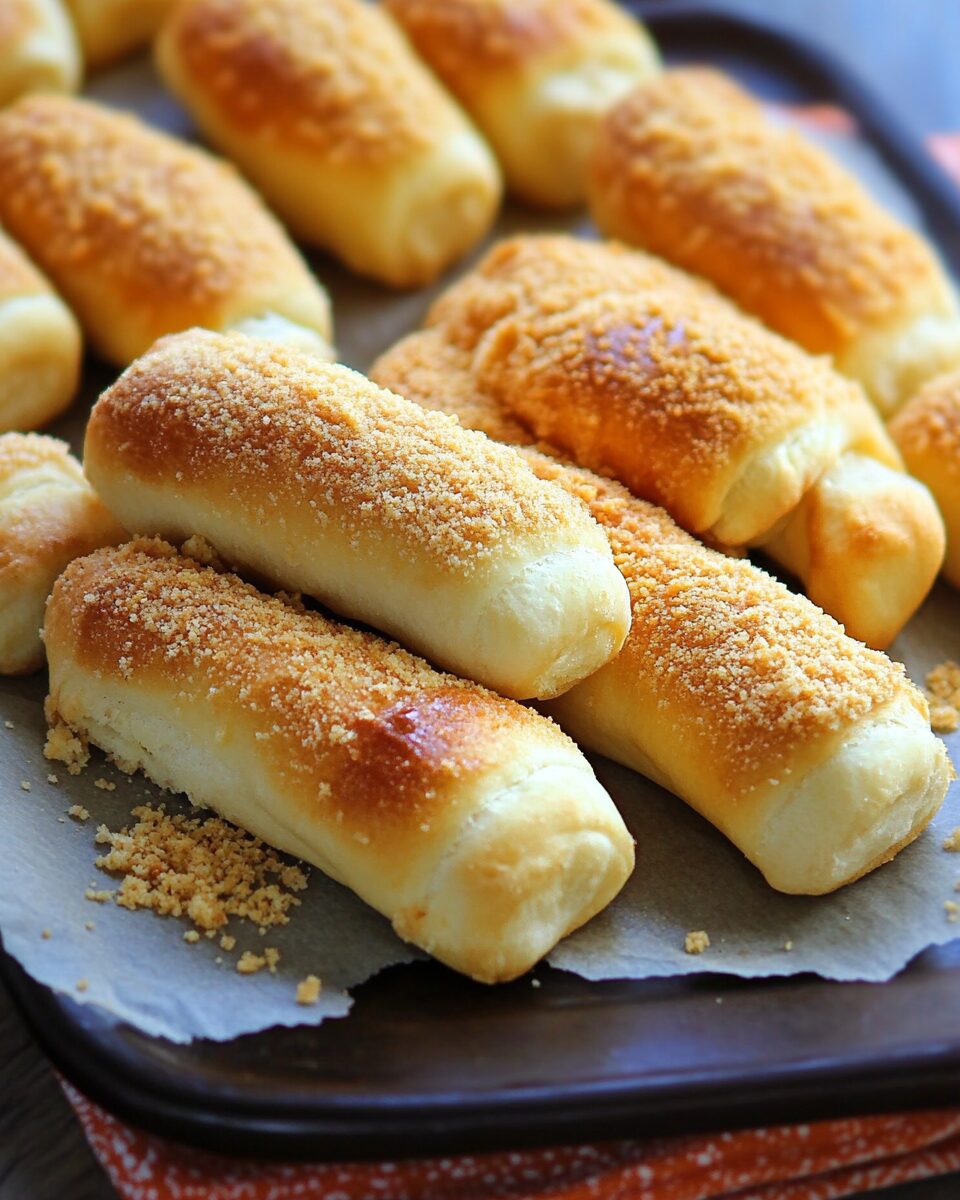Spanish Bread is a popular Filipino bakery treat known for its soft, fluffy texture and sweet, buttery filling. Often enjoyed as a snack or breakfast item, these rolls are coated with breadcrumbs and baked until golden, creating a delightful contrast between the soft bread and its slightly crisp exterior.
FULL RECIPE
Ingredients
- 3 ½ cups all-purpose flour
- 1 packet (2 ¼ tsp) active dry yeast
- ¾ cup warm milk
- ¼ cup granulated sugar
- 1 tsp salt
- ¼ cup unsalted butter, melted
- 1 large egg
- ½ cup breadcrumbs (for coating)
1.For the filling
- ½ cup brown sugar
- ¼ cup unsalted butter, softened
- ¼ cup breadcrumbs
- 1 tsp vanilla extract (optional)
Directions
- In a bowl, dissolve yeast and 1 tablespoon of sugar in warm milk. Let sit for 5–10 minutes until foamy.
- In a large mixing bowl, combine flour, remaining sugar, and salt.
- Add the yeast mixture, melted butter, and egg to the dry ingredients. Mix until a dough forms.
- Knead the dough on a floured surface for about 8–10 minutes, or until smooth and elastic.
- Place the dough in a greased bowl, cover, and let rise in a warm place for 1 to 1.5 hours, or until doubled in size.
- While the dough is rising, prepare the filling by mixing brown sugar, softened butter, breadcrumbs, and vanilla extract until well combined.
- Punch down the risen dough and divide it into 12 equal portions.
- Roll each piece into a flat oval, spread a spoonful of filling, and roll tightly from one end to the other like a log.
- Lightly brush each roll with melted butter and roll in breadcrumbs to coat.
- Arrange the rolls on a baking tray lined with parchment paper. Cover and let rise for another 30–45 minutes.
- Preheat oven to 350°F (175°C). Bake the rolls for 15–20 minutes or until golden brown.
- Let cool slightly before serving.
Nutritional Information
- Calories: 220
- Fat: 9g
- Carbohydrates: 30g
- Protein: 4g
- Sugar: 10g
- Fiber: 1g
- Sodium: 180mg
Origin of Spanish Bread
Despite the name, Spanish Bread is not from Spain but is a beloved Filipino pastry. It was likely inspired by Spanish-influenced baking traditions during the colonial period in the Philippines. Spanish Bread has evolved into a distinct creation known for its buttery filling and breadcrumb coating, making it a staple in Filipino panaderias (bakeries) and households.
Cultural Significance
Spanish Bread holds a nostalgic place in Filipino culture. Many Filipinos associate it with childhood memories, merienda (afternoon snack) breaks, or early mornings at the bakery. It’s a symbol of comfort and community, often shared among family members or given as a thoughtful treat.
Texture and Flavor Profile
The unique combination of a soft, fluffy roll and a sweet, buttery, breadcrumb-laced filling sets Spanish Bread apart. The outer coating of breadcrumbs provides a slight crispness that contrasts beautifully with the tender dough and rich, sugary interior. This combination creates a multi-textured eating experience that many find irresistible.
Common Variations
Although the traditional recipe remains popular, there are many modern variations of Spanish Bread. Some bakers incorporate grated cheese into the filling for a salty-sweet twist, while others add cinnamon or ube flavoring. Vegan and gluten-free versions have also emerged, accommodating those with dietary restrictions.
Baking Techniques
Making Spanish Bread successfully requires careful attention to dough development and proofing. Kneading the dough thoroughly builds gluten for that desired pillowy texture. Proofing must be done in a warm, draft-free environment to allow the yeast to activate properly. A well-kneaded and correctly proofed dough is key to the bread’s softness.
Importance of the Filling
The filling is the heart of Spanish Bread. Typically made from brown sugar, butter, and breadcrumbs, it adds sweetness and moisture to the roll. Some versions also include a splash of vanilla or condensed milk for extra richness. The filling is spread thinly to avoid spillage during baking, yet generously enough to deliver that signature taste in every bite.
Role of Breadcrumb Coating
The breadcrumb coating is not just decorative—it provides a slight crunch and absorbs some moisture from the buttery filling during baking, creating a golden, textured exterior. This technique is also a clever way to prevent the rolls from sticking together during baking.
Ideal Serving Suggestions
Spanish Bread is best served warm, ideally straight from the oven or reheated slightly. It pairs excellently with hot beverages such as coffee, tea, or hot chocolate. Some enjoy it as a standalone snack, while others include it in a larger Filipino breakfast spread alongside eggs and fried rice.
Storage and Shelf Life
While Spanish Bread is best enjoyed fresh, it can be stored in an airtight container at room temperature for up to two days. For longer storage, freezing is recommended. Reheat frozen Spanish Bread in an oven or toaster oven to restore its soft texture and revive the flavors.
Homemade vs. Store-Bought
Homemade Spanish Bread offers the advantage of customizing ingredients and controlling sweetness, saltiness, and richness. While store-bought versions are convenient, they may use preservatives or lower-cost alternatives that affect flavor and texture. Many home bakers prefer the fresher, more authentic taste of homemade versions.
Nutritional Perspective
Spanish Bread is indulgent but can be modified for health-conscious individuals. Using whole wheat flour, reducing sugar, or substituting butter with plant-based alternatives can lower the calorie and fat content. However, due to its sweet nature and carb-rich composition, it is best enjoyed in moderation.
Economic Considerations
Spanish Bread is a cost-effective snack, using common pantry ingredients such as flour, sugar, butter, and milk. Its affordability makes it accessible for everyday consumption and profitable for small-scale bakers and local bakeries.
Popularity in Overseas Filipino Communities
Filipinos living abroad often seek Spanish Bread in specialty Asian markets or make it at home to recreate a taste of home. Its presence in Filipino communities worldwide reflects its strong cultural pull and the shared love for traditional baked goods.
Kid-Friendly Appeal
With its soft texture and sweet taste, Spanish Bread is particularly loved by children. It’s easy to eat, not overly messy, and can be a great introduction to Filipino flavors for younger generations. Parents often include it in lunchboxes or serve it as an after-school snack.
Pairings with Other Filipino Dishes
Spanish Bread pairs well with other Filipino favorites like champorado (chocolate rice porridge) or arroz caldo (chicken rice porridge). It complements savory dishes as a sweet counterbalance and can be served in casual or festive meals.
Celebratory and Everyday Roles
While commonly eaten as a daily snack, Spanish Bread is also featured during holidays and family gatherings. It is often served alongside more elaborate dishes or given as a gift during special occasions. Its dual role in both daily life and celebrations speaks to its versatility.
Small Business Potential
Due to its popularity and low production cost, Spanish Bread offers strong potential for home-based or small bakery businesses. It’s relatively simple to scale, easy to package, and appeals to a wide audience. Many successful Filipino entrepreneurs have built businesses around classic breads like this one.
Learning Curve for Beginners
Spanish Bread is a great starting point for beginner bakers. It introduces key bread-making techniques such as proofing, kneading, and shaping. While precision is required, it’s forgiving compared to more advanced pastries, making it ideal for those looking to build confidence in the kitchen.
Ingredient Substitutions
Several substitutions can be made without compromising the essence of Spanish Bread. Non-dairy milk and butter can replace traditional versions for lactose-intolerant individuals. Coconut sugar can substitute brown sugar, and gluten-free flour blends can be tested for those with gluten sensitivities.
Global Influence and Fusion
Modern bakers and food creatives are incorporating global flavors into Spanish Bread, such as matcha, Nutella, or pandan. These fusions blend traditional Filipino comfort food with contemporary tastes, helping the bread evolve while staying rooted in its cultural foundation.
Conclusion
Spanish Bread continues to be a cherished part of Filipino culinary heritage, reflecting the fusion of tradition and adaptability. Its irresistible combination of soft bread, sweet filling, and crisp coating appeals across generations. Whether made in a humble home kitchen or sold in a bustling bakery, Spanish Bread is a reminder of comfort, culture, and community. As it continues to evolve through creative variations and modern takes, it remains a nostalgic and essential part of the Filipino food experience.






